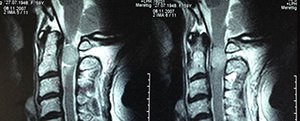What is a spinal meningioma?
Spinal meningioma (also called meningioma or meningeoma) is a usually benign tumor within the spinal canal. This tumor results from the degeneration of cells of the arachnoid membrane. This is a meninges, also called spinal meninges. Malignant degenerations or tumors are extremely rare.
Meningiomas in general are benign (benign) tumors that arise from the meninges. The meninges carry the medical term meninges, which explains the naming of meningiomas. The meninges lie like a protective covering around our spinal cord and brain.
Meningioma as such is not a life-threatening disease, but it still should not be underestimated. The benign tumor grows slowly. Because of its gradual growth, it can go undetected for a long time, leading to severe disability and life-threatening situations. As it grows, it can compress the spinal cord and the nerve root, thus impairing their function. It can spread throughout the spinal canal, which is also called the spinal cord canal or spinal canal.
Meningiomas are classified into three different grades. These are:
- slow-growing (benign) meningiomas (WHO grade I).
- atypical meningiomas (WHO grade II) that tend to recur (grow again)
- fast-growing anaplastic meningiomas (WHO grade III)
How many people in Germany are affected by a meningioma?
In Germany, about 50,000 people are affected by meningiomas every year. Possibly many more meningiomas grow, but statisticians or scientists cannot count them because they have never been discovered.
On average, more women are affected than men. For every three women with meningiomas, only two men are counted. Adults are most often affected, usually around the age of 45. In children and adolescents, they occur very rarely, at 2 percent.
Most of the 50,000 meningiomas grow in the brain. It is estimated that ten percent (i.e. 5,000) form in the spinal canal, i.e. not far from the spinal cord. Meningiomas in the spinal column affect men and women equally.
The symptoms of spinal meningioma
The complaints and symptoms of a spinal meningioma depend very much on where exactly the tumor is located. It can take years before the meningioma shows any symptoms at all. This is because this tumor grows very slowly. But at the latest, when neighboring structures such as nerves or important regions of the brain are displaced, the first symptoms appear. Localization and treatment should take place at the latest then.
Meningiomas of the cervical spine, thoracic spine, lumbar spine
Most often, patients suffer from local pain in the area of the tumor. In the case of meningioma in the cervical spine (cervical spine meningioma), the pain may radiate to the arms, and in the case of tumor in the thoracic spine (thoracic spine), pain radiates around the chest.
Pain radiates into the legs (such as sciatic pain) if the meningioma is established in the lumbar spine. As compression progresses, numbness, gait disturbances, bladder dysfunction can occur - in the worst case, paraplegia is possible in addition to neurological deficits.
Diagnosis of meningioma
In order to make an accurate diagnosis, a specialist (neurosurgeon, neurologist or orthopedist) is always needed. Before your doctor orders imaging procedures, he will conduct the so-called anamnesis interview with you. He will want and need to know from you what complaints have been occurring since when and where. He will certainly also ask about any underlying diseases.
After that, the specialist will decide whether to perform a computer tomography (CT) or a magnetic resonance imaging (MRI). In this way, the meningioma in the spinal canal can either be confirmed or excluded. Thanks to modern incision techniques, this also allows for a binding classification of the tumor. A contrast medium injected into the patient's vein literally makes the tumor on the spinal column glow. This means that it is clearly visible and cannot hide.
Depending on its size and location, the meningioma can then simply be observed or, especially in the case of neurological disorders, removed. Thus, removal is not always mandatory.
This is how the Avicenna Clinic treats meningiomas
The choice of the therapy depends on the size and localization of the meningioma, but also on the patient's complaints. In the case of surgery, we will perform a microsurgical one, which will allow us to remove the meningioma completely.
After removal of the tumor, the symptoms disappear usually immediately. In exceptional cases (if the tumor could not be completely removed), radiation therapy may follow.
If after the operation you feel sensitive dysfunction, they will disappear on their own within one year. Chemotherapy is only an option if the actual benign meningioma is about to degenerate – which means that the cells become malignant. The danger exists only in 1.7% of the cases.
Prognosis on meningiomas - control examinations
In benign meningiomas, surgery is usually the cure. This tumor does not form metastases. Nonetheless, follow-up examinations (MRI, CT) are recommended every six to twelve months and longer. In case of relapse, it will be detected early and can be treated easily (usually operated once again).
The Avicenna Clinic in Berlin is always willing to help you
Since the year 2001, the Avicenna Clinic is based in Berlin. Our doctors have at least 25 years of international experience in their respective fields (neurosurgery, spinal surgery, anesthesia, and orthopedics).
If you have severe back pain, a herniated disc or a suspected herniation, please contact us using the following information:



